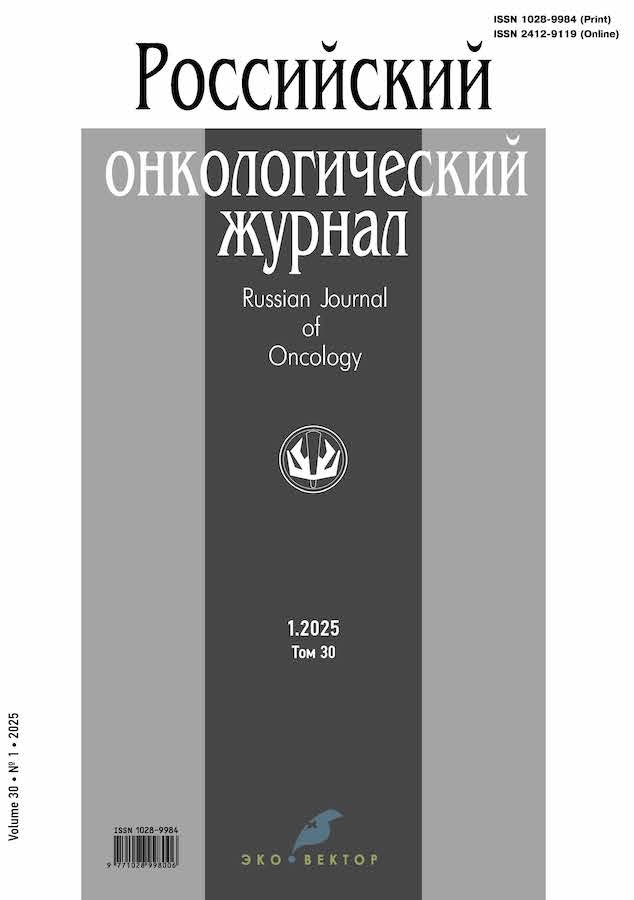Clinical and Dermatoscopic Features of Amelanotic Cutaneous Melanoma: a Single-Center Experience
- Authors: Titov K.S.1, Tamrazov R.I.2, Zykova D.D.3, Zhdanova V.V.3, Sukharnik E.I.2
-
Affiliations:
- Botkin Moscow Multidisciplinary Research and Clinical Center
- Tyumen State Medical University
- Medical City Multidisciplinary Clinical Medical Center
- Issue: Vol 30, No 1 (2025)
- Pages: 25-30
- Section: Original Study Articles
- Submitted: 27.05.2024
- Accepted: 20.05.2025
- Published: 23.06.2025
- URL: https://rjonco.com/1028-9984/article/view/632423
- DOI: https://doi.org/10.17816/onco632423
- EDN: https://elibrary.ru/ZCLYEY
- ID: 632423
Cite item
Abstract
BACKGROUND: Malignant skin tumors occupy the second place among all oncological diseases worldwide. The most aggressive among them is skin melanoma, and of particular interest is its subspecies — pigmentless melanoma, which occurs from 2 to 8% among all skin malignancies. The atypical dermatoscopic picture, the frequent detection of pigmented melanoma in advanced stages, and its aggressive course, which worsens long-term treatment results, require a closer study of the issue and improvement of methods for early detection of the disease.
AIM: Analysis of clinical cases of pigmented skin melanoma with assessment of pathognomonic clinical and dermatoscopic picture.
METHODS: A retrospective analysis of the data of patients with pigmentless melanoma of the skin provided from the cancer registry of the Tyumen region for 2018-2023 was performed.
RESULTS: During the study, it was revealed that at the initial request for medical help, most of the patients were not bothered by the existing pigmentation-free formation, and complaints of rapid growth of the lesion and contact bleeding were less common. When assessing the localization of tumors, it was found that pigmented melanoma was most common on the skin of the trunk (in 38.4%), less often on the skin of the head and neck (26.9%) and only in isolated cases on the skin of the upper and lower extremities. The primary lesion more often had the appearance of a node or papule, less often — spots or plaques. When assessing the dermatoscopic picture, vascular polymorphism became the most common feature (43.18%), regression zones were slightly less common. In exceptional cases, it was impossible to assess the dermatoscopic picture due to tumor disintegration.
CONCLUSION: The rare occurrence of pigmented skin melanoma in clinical practice, the atypical dermatoscopic picture of the primary focus and the asymptomatic course are predictors of late diagnosis of the disease, which exacerbates the further course of the oncological process and long-term treatment results. This indicates to us the need to increase cancer awareness regarding pigmented melanoma of the skin, and the study and identification of typical clinical and dermatoscopic signs is an essential step towards early diagnosis of the malignant pathology in question and timely treatment of patients.
Full Text
About the authors
Konstantin S. Titov
Botkin Moscow Multidisciplinary Research and Clinical Center
Email: ks-titov@mail.ru
ORCID iD: 0000-0003-4460-9136
SPIN-code: 7795-6512
MD, Dr. Sci. (Medicine), Professor
Russian Federation, MoscowRasim I. Tamrazov
Tyumen State Medical University
Email: rasim@tamrazov.com
ORCID iD: 0000-0002-6831-6971
SPIN-code: 3162-8607
MD, Dr. Sci. (Medicine)
Russian Federation, TyumenDaria D. Zykova
Medical City Multidisciplinary Clinical Medical Center
Author for correspondence.
Email: zyksss93@gmail.com
ORCID iD: 0009-0005-9637-182X
SPIN-code: 2873-9797
Russian Federation, Tyumen
Valeria V. Zhdanova
Medical City Multidisciplinary Clinical Medical Center
Email: Lera4598@mail.ru
ORCID iD: 0000-0001-7302-7456
SPIN-code: 8854-4339
Russian Federation, Tyumen
Eugenia I. Sukharnik
Tyumen State Medical University
Email: eva.sukharnik@mail.ru
ORCID iD: 0009-0004-9785-237X
Russian Federation, Tyumen
References
- Kirova MV, Shcherbakov PL, Khomeriki SG, et al. Small-Intestine Metastases of Amelanotic Melanoma: Clinical Case. Doctor.Ru. Gastroenterology. 2015(12):19–22. EDN: UNJRRX
- Chulkova SV, Chernysheva OA, Markina IG, et al. Stem tumor cells of melanoma. Bone marrow involvement. Review and own data. Bulletin of the Russian Scientific Center of X-ray Radiology. 2019;19(4):182–197. (In Russ.) EDN: IYEZER
- Kubanov AA, Gallyamova YuA, Bisharova AS, Sysoeva TA. Features of amelanotic melanoma diagnostics. The Lechaschi Vrach Journal. 2018(8):76–79. EDN: XYWDDF
- Pavlov YuI, Volkov VV, Gromov IA, Kholopov AA. Clinical case of a patient with subungual melanoma. Ambulatory Surgery. 2020;(3–4):61–65. doi: 10.21518/1995-1477-2020-3-4-61-65
- Shcherbakov PL, Kirova MV, Khomeriki SG, et al. Pigmentless melanoma of the small intestine. Doctor.Ru. 2015;(2–2):46–47. (In Russ.) EDN: UBMSHL
- Titov KS, Glumsky VV, Zapirov MM, et al. Amelanotic melanoma: current state of the problem. Farmateka. 2022;(14):94–99. doi: 10.18565/pharmateca.2022.14.94-99
- Blokh AI. Etiology and risk factors for nonmelanoma skin cancers and melanoma: a review of literature. Medicine in Kuzbass. 2015;14(4):71–76. EDN: WKEXFF
- Shamrikova VA, Sorokina ED, Dubrovskaya EV, et al. Mexametric Assessment of Melanin Level in Children’s Skin. Acta Biomedica Scientifica. 2020;5(2):12–16. doi: 10.29413/ABS.2020-5.2.2
- Vakhitova II, Michenko AV, Potekaev NN, et al. The prevalence of risk factors for development of melanoma among dermatological patients. Russian Journal of Clinical Dermatology and Venereology. 2020;19(5):630–636. doi: 10.17116/klinderma202019051630
- Lamotkin IA, Kapustina OG, Mukhina EV, Varakina SV. Early diagnosis of melanoma: current challenge for a modern clinician. Medical Bulletin of the Main Military Clinical Hospital named after N.N. Burdenko. 2021;(3):50–54. doi: 10.53652/2782-1730-2021-2-3(5)-50-54
- Khismatullina ZR, Chebotaryov VV, Babenko EA. Dermatoscopy in Dermato-Oncology: Current State and Perspectives. Creative surgery and oncology. 2020;10(3):241–248. doi: 10.24060/2076-3093-2020-10-3-241-248
- Garanina OE, Samoylenko IV, Shlivko IL, et al. Non-invasive diagnostic techniques for skin tumors and their potential for use in skin melanoma screening: a systematic literature review. Medical Council. 2020;(9):102–120. doi: 10.21518/2079-701X-2020-9-102-120
- Lapkina EZ, Palkinа NV, Averchuk AS, et al. Antitumor, toxicity and target gene expression evaluation of MiR-204-5p mimic application on melanoma b16-bearing mice. Siberian journal of oncology. 2022;21(3):61–69. doi: 10.21294/1814-4861-2022-21-3-61-69
Supplementary files








